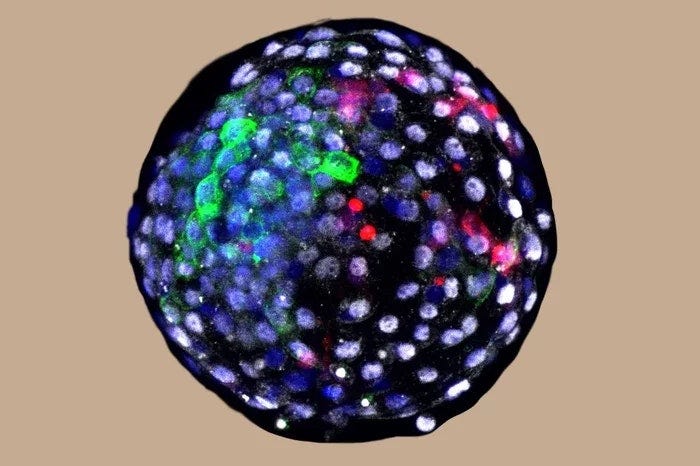Exploring the Potential of Monkey-Human Hybrid Embryos for Organ Shortage Solutions
Written on
Chapter 1: The Organ Shortage Crisis
There is a significant shortage of organs available for transplantation. The demand for organs is high, and current methods do not easily allow for an increase in supply. While the idea of magically summoning organs might be appealing, the reality is that we need to fundamentally rethink our approaches or develop human organs that can be cultivated from animal sources.
Recently, a significant development in the field of regenerative medicine has sparked extensive dialogue among ethicists and scientists.

Led by renowned regenerative medicine expert Juan Carlos Izpisua Belmonte at the Salk Institute, researchers successfully integrated human cells into monkey embryos, which grew for nearly three weeks before the last embryo perished at 19 days. According to reports, “On average, human cells constituted about 3% to 4% of the embryos, with one embryo containing up to 7%.”
The implications of these findings remain unclear, and critics have voiced concerns regarding the creation of entities that may resemble concepts from dystopian films. Nevertheless, it appears that scientists will persist in this area of research, potentially uncovering new avenues to save lives through hybrid organ transplants.
Section 1.1: Historical Context of Hybrid Research
The journey toward hybrid research began in the UK in 2007 when Newcastle University and King’s College London received approval from the Human Fertilisation and Embryology Authority to explore the creation of human-bovine hybrid embryos. This effort aimed to produce embryonic stem cells for further investigation into human diseases.
These embryos were predominantly human, composed of 99.9% human cells and less than 0.01% bovine cells. However, this did not prevent significant backlash from right-wing media and the Catholic Church.
What were the key factors for progress?
Three elements proved essential: a competent regulatory framework, legislators open to dialogue, and scientists who advocated for their work as passionately as they researched.
Unfortunately, achieving this balance, especially in the US, has proven challenging. At that time, a ban on chimeric embryos was still in place, which the NIH did not lift until 2015, following considerable debate. Belmonte sought permission to continue his research, leading to the establishment of an ethics review panel to replace the previous moratorium.
Since then, there has been considerable advancement in the area of human-pig and human-sheep hybrids, particularly from a company co-founded by George Church, which has focused on using CRISPR technology on pigs. Japan has also lifted its restrictions on hybrid embryo research.
Section 1.2: The Artistry of Regenerative Medicine Research
Regenerative medicine researchers are akin to artists; they embody innovation and creativity in biotechnology. Belmonte exemplifies this spirit. As noted by George Daley, a stem cell researcher and dean of Harvard Medical School, “Juan Carlos combines rigor with an adventurous spirit, producing science that continually surprises us.”
Chapter 2: Ethical Considerations in Hybrid Research
The creation of human-animal hybrids raises complex ethical dilemmas. On one hand, the urgent need for viable organs to save human lives is undeniable. On the other hand, questions arise regarding how much “human” genetic material can be present in an animal before it alters its moral standing. Is 5% acceptable, or does it become concerning as the percentage increases? Moreover, could these animals develop cognitive or emotional capacities similar to humans?
While it is improbable, it is crucial to consider whether any presence of human cells could elevate the ethical status of a pig or monkey. Thankfully, numerous ethicists are examining these critical questions. Each new study, such as the recent findings mentioned, often leads to heightened media attention and complex responses from ethicists who provide insights that are not always straightforward. The reality is that our understanding of these hybrids is still in its infancy.
We require open discussions, legislators willing to engage with the science, and scientists capable of effectively communicating their research to the public without inciting fear.
Takeaways from the Human-Monkey Hybrid News
“The emergence of lab-generated human embryo models that closely mimic actual human embryos intensifies the conversation. Likewise, the recent advancements in growing mouse embryos in lab conditions have taken gestation further than previously achieved. Some experts are already discussing the potential of cultivating human embryos for extended periods. It’s premature to pursue that.” — Dr. Paul Knoepfler, stem cell expert.
“I find the quality of the research to be quite low. The imagery of the embryos does not meet current standards, making it difficult to verify their claims. The manuscript contains nine figures, but only three depict embryos, and the quality of those images complicates distinguishing the different cell types. Most importantly, there is no clear evidence of a day 19 chimera to support their claims.” — Dr. Alfonso Martinez Arias, University of Cambridge.
“This study challenges the widely accepted notion that human embryos would not be analyzed past 14 days in vitro. While it doesn’t formally breach this guideline, the experiments effectively sidestep the 14-day rule. Such studies may become unnecessary if this rule is updated, providing strong justification for reconsidering it.” — Prof. Martin Johnson, University of Cambridge.
Additional Perspectives
“My primary question is: Why proceed? I believe the public will be apprehensive, and I share that concern, about advancing science without a thorough discussion on the ethical implications.” — Kirstin Matthews, Rice University’s Baker Institute.
“I don’t perceive this research as ethically problematic. Its objectives align with significant humanitarian goals.” — Insoo Hyun, bioethicist.
“The need for public dialogue regarding human/non-human primate research is vital. Surprising the public with unexpected research outcomes can undermine trust in science.” — Hank Greely and Nita Farahany in Cell.
This video discusses the ethical implications surrounding human cells grown within monkey embryos, highlighting the ongoing debate in the scientific community.
This video delves into the reasons behind the creation of human-monkey hybrids, exploring the scientific motivations and ethical considerations involved.